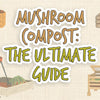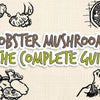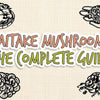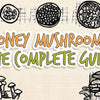Chanterelle Mushrooms: Everything And More
Nutty to taste, golden to look at and extremely difficult to grow. Just a few of the qualities that make the Chanterelle Mushroom so unique. We aim to provide you with a comprehensive guide. Included is everything from nutrition and health benefits to foraging, cleaning and cooking.
Not Much Time? Skip To What You'd Like To Learn...
-
History
-
Commonly Found Varieties
-
Health Benefits
-
Foraging
-
Why Are They So Expensive?
-
Cleaning For Eating
-
How To Preserve
-
Dehydrating
-
Freezing
-
Pickling
-
Mushroom Recipes

History
The chanterelle mushroom gained popularity after the French nobility started to eat them in the 18th century. Prior to this records show them being eaten as early as the 16th century. Since then they have become a prized delicacy noted for their slightly peppery taste. Commonly appearing on menus all over the world.
Commonly Found Varieties

Chanterelle became the common name for multiple genus. Each genus is different in look, taste and location found. Below we aim to introduce you to 5 variations of mushrooms that are commonly known as chanterelle mushrooms.
Cantharellus Cibarius: notarised for its golden or yellow colour this mushroom can be found in the western area of North America (west of the rocky mountains) as well as in Europe. This mushroom is a European specie, previously many mushroom species were clumped together to form the cantharellus cibarius.
Cantharellus Cinnabarinus: named after its appearance this mushroom is a distinctive pink-red colour. This mushroom is said to have a sweet and fragrant smell. It can be found in eastern North America between summer and fall.
The Smooth Chanterelle: or otherwise known as Cantharellus Lateritius. This mushroom can be found in North America, Asia and also Africa. In North America the smooth chanterelle will fruit between late spring to early summer. Delicious to eat too.
Cantharellus Minor: the smallest of the chanterelle fungus family. It has a distinct and very slim stem. You can find this mushroom growing on hardwood and moss environments, in the Pacific Northwest, between spring and fall.
Cantharellus Roseocanus: this mushroom is interesting to look at. Looking slightly like a sponge when you find it. The mushroom is white in color and stubby in appearance. Like many others chanterelle species you will find this growing in the Pacific Northwest.
Health Benefits

Mushrooms have been thought to have healing properties for thousands of years, particularly in eastern and traditional Chinese medicine. However it’s only been in the last few decades that western studies have come out proving this to be true.
They're very high specifically in vitamin B3, vitamin D, iron, copper and magnesium. Which are all essential for healthy body functions.
5 Health Benefits:
High In Fibre Healthy amounts of dietary fibre have been shown to improve bowel health, control your blood sugar levels and decrease cholesterol levels.
Anti-Inflammatory it’s thought that chronic inflammation can cause a variety of diseases including cancers in patients. Studies have shown that consuming chanterelle mushrooms can lower inflammation (1).
High In Vitamin B12 People with restrictive diets such as strict vegan diets often find it harder to find natural food sources containing vitamin B12. This is due to vitamin B12 being synthesized by specific bacteria most commonly found higher up the food chain. Vitamin B12 is essential for our body to keep nerve and blood cells healthy.
Cardiovascular Health cardiovascular disease is one of the highest mortality risk factors in the western world. Studies have shown that edible mushrooms may reduce the risk of cardiovascular disease.
Boost Your Immune System It’s thought that mushrooms attack the immune system, although non-toxic it causes the body’s immune system to respond and fight it. The triggering of the immune system response is thought to strengthen it.
Foraging

Although chanterelle mushrooms can be found all over the world we will focus on those that can be found in the United States. There are over 20 species growing in the United States. So for simplicity this foraging guide we will focus on the smooth chanterelle mushroom (Cantharellus Lateritius). This is probably the most commonly eaten type of mushroom.
When foraging we would always recommend using mushroom knife for ease of use, and a clean cut. Interested in mushroom knives? Click Here For The Complete Guide To Mushroom Knives
Where To Find?
Commonly found growing on hardwood or in moss, this mushroom grows in every state in the US, expect Hawaii!
When To Find Them?
Chanterelle fruiting season starts at the end of spring to early summer all the way through until the first frost. These mushrooms need a lot of rain to fruit. We would suggest it’s best to head out foraging after a few days of heavy rain.
How To Pick?
Using a mushroom knife, slice at the base of the mushroom. Pulling at the roots is likely to prevent spores from dropping to the floor.
How To Identify?
WARNING: never pick or eat wild mushrooms unless under the strict guidance of an expert. Below is a brief overview for those interested in certain characteristics and not to be taken as a guide. In the US there are the western jack o lantern mushroom and many others which are poisonous look-a-likes.
Bright yellow to orange in color the smooth chanterelle mushrooms are often confused to be golden chanterelle for this reason
Underside of the cap is smooth this is where the mushroom get their “smooth chanterelle” name from. Check the underside of the mushroom to see if it’s a smooth surface with no gills.
2.5-8 cm cap size. When measuring the size of the cap, edge to edge, it will be roughly between 2.5-8 cm or 1-3 inches across.
The odor is fragrant and sweet and normally strong too.
Be aware that the Jack O’lantern mushroom is just one example of a false poisonous look alike therefore only forage for mushrooms under the guidance of an expert.
Why are they so expensive?
At your local farmers market or health food store it is common to see 1lb (around 500g) of chanterelle mushrooms sell for between $20 - $30.
The biggest reason they’re so expensive is because they’re foraged for. Being handpicked means that foragers spend a lot of time and effort going to hunt for this specie.
Researchers and scientists have been trying to crack the code of how to commercially grow chanterelle mushrooms. It is believed that they have a symbiotic relationship with trees where by they exchange nutrients allowing them to grow.
Fully understanding this relationship may allow us to recreate it in an artificial environment. Until this day they will remain an expensive delicacy.
Want to know our Top 10 Mushrooms Growing Kits? We have a full and comprehensive guide to the best growing kits and considerations before buying one too! Check out our Top 10 Mushroom Growing Kits Here.
Cleaning
In order to have your mushrooms dry before consuming, plan to start this a few hours before you want to cook. If your in a rush you can cook when they’re damp, although not advised.
Tools Required
-
Soft paint brush or cloth for cleaning
-
Towel or Colander for drying
1. Hold your mushroom under running water and brush the mushroom all over to remove dirt
2. After removing all visible dirt from the mushroom place on a towel or in a colander, this is to ensure your mushrooms are dry before eating
3. To speed up the drying process we would recommend to place your mushrooms on the window seal
How To Preserve

As chanterelle mushrooms are seasonal and often found in large quantities it may be necessary to preserve them. By preserving your chanterelle mushrooms you are able to enjoy them all year round.
Below are three different methods to preserve your mushrooms. There are many ways to do each method, so we selected each recipe with a focus on it being easy and not time consuming.
Dehydrating
Dehydrated chanterelle mushrooms are best for soups, stews or broths. When rehydrated their texture changes. If you’re looking to use them for sautéing it’s best to consider freezing them.
1. Clean your mushrooms thoroughly before you begin
2. Slice your mushrooms to your desired thickness, remember the thicker they’re the longer they will take to dehydrate
3. Place on your dehydrator tray with all of the mushrooms side by side, no overlapping
4. Leave until dry and crispy! Depending on your dehydrator and thickness of mushroom expect it to take anywhere between 5-8 hours
Freezing Chanterelle Mushrooms
If you’re looking for an easy solution when cooking and for long term storage this may be your preferred method. As chanterelle mushrooms don’t rehydrate that well we would recommend this solution to best keep the flavours.
Here is a complete guide to mushroom freezing.
Before freezing mushrooms they need to be sautéed or cooked otherwise their texture will be mushy, due to their high water content.
When cooking the mushrooms they will pick up and retain the flavour of the fat that they’re cooked in. For this reason be sure to think about what you cook them in.
1. Clean your chanterelle mushrooms thoroughly
2. Slice into your desired size to sauté
3. Place your pan over a medium heat and add your cooking fat
4. Add your mushrooms and stir
5. When finished your mushrooms should be a nice golden brown color
6. Remove from the heat and let your mushrooms cool down
7. Once cool place in a freezer bag, mark the date and the type of mushroom
8. Ready to go into the freezer
Most mushrooms can be left in the freezer for up to one year. When you’re ready to use just remove from the freezer your desired amount and they’re ready to be cooked.
Pickling
Pickling mushrooms is an age old tradition. Originally a solution for preserving food for sailors, explorers or just for preserving your harvest. The recipe below is quick and simple.
Ingredients Required
-
2 lbs Of Chanterelle Mushrooms
-
2 Cups Of White Wine Vinegar
-
2-4 Cloves Of Garlic
-
2-4 Dried Chillies
-
4 Sprigs Of Thyme
-
1 tbsp Of Sea Salt
Pickling Recipe
1. Clean your mushrooms thoroughly
2. Add your mushrooms, vinegar, garlic, thyme, chillies, salt and water into a pot
3. Bring your pot to the boil and then let it simmer
4. Cook for roughly 10 minutes, it will be ready when your chanterelle mushrooms have shrunk and glossy or shiny to look at
5. When finished spoon your cooked mushrooms, vinegar, garlic, chilli (leave the thyme) into your jar
6. Pour your brine into the jar covering the ingredients - be sure to leave roughly 1” of room in the top of the jar
7. Leave in a cool environment to let cool down, leave for at least 10 days before eating
8. Be sure to add a label with what’s inside and the date pickled
9. Once opened leave in the fridge
For longer term storage it is necessary to use a specific canning jar, as well as boiling that jar in water once sealed. The method above should keep your pickled mushrooms good for 6 months when in the fridge.
Chanterelle Mushroom Recipes
Chanterelle mushrooms are prized by chefs for their, taste, texture and fragrance - a true seasonal delicacy. A few recipes that use chanterelle mushrooms are outlined below.
Creamy Chanterelle Pasta
Ingredients
-
1 lb (500g) of your chosen pasta
-
½ lb (250g) of chanterelle mushrooms
-
1 tbsp of butter
-
1 tbsp of olive oil
-
1 small handful of parsley roughly chopped
-
2 cloves of garlic
-
Parmesan for topping
-
A Pinch of salt and pepper
Recipe
1. Put a large pot of water over a high heat and bring to the boil
2. Once boiling add your pasta in
3. Cook your pasta until al dente
4. Start by putting a pan over a medium heat
5. Add your butter and olive oil
6. Add your mushrooms, garlic, parsley, salt and pepper to the pan
7. Once your mushrooms are cooked add you pasta
8. Stir together until combined
9. Serve with parmesan sprinkled over
Sautéed Chanterelle Mushrooms
Inspiration… This recipe is ideal with sliced bacon or with poached eggs for breakfast
Ingredients
-
½ lb (250g) of chanterelle mushrooms
-
1 tbsp of butter
-
1 tbsp of olive oil
-
1 small handful of parsley roughly chopped
-
2 Cloves of garlic
-
Parmesan for topping
-
A pinch of salt and pepper
Recipe
1. Start by putting a pan over a medium heat
2. Add your butter and olive oil
3. Add your mushrooms, garlic, parsley, salt and pepper to the pan
4. Sauté until golden brown, it may take up to 10 minutes
5. Serve






